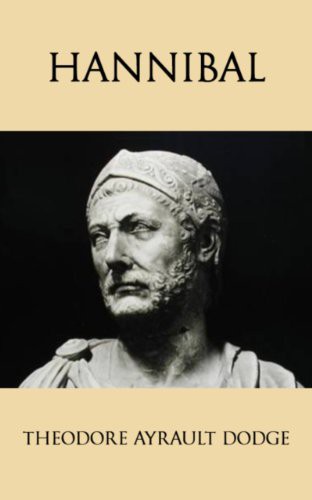Hannibal
A History of the Art of War
Among the Carthaginians and Romans
Down to the Battle of Pydna, 168 B.C. ,
With a Detailed Account of the Second Punic War
With 227 Charts, Maps, Plans of Battles and Tactical Manuvres, Cuts of Armor, Weapons and Uniforms
By Theodore Ayrault Dodge
Brevet Lieutenant Colonel
United States Army, Retired List
Originally published by Houghton, Mifflin and Company, 1891
This edition copyright 2012 Tales End Press
978-1-62358-004-9
eBook Notes
This ebook includes over 200 campaign maps, battle diagrams, and illustrations. To avoid breaking up the flow of the text, they are shown inline in a reduced form, often at less than half of their full size. Please use the zoom feature of your ebook reader to see them in their full glory!
We love to get feedback and suggestions just email .
These Volumes Are Dedicated To
The American Soldier
Who, Not Bred To Arms,
But Nurtured By Independence,
Has Achieved The Proudest Rank
Among The Veterans Of History
Faites la guerre offensive comme Alexandre, Annibal, Csar, Gustave Adolphe, Turenne, le prince Eugne et Frdric; lisez, reilisez lhistoire de leur quatre-vingt-huit campagnes; modlez-vous sur eux cest le seul moyen de devenir grand capitaine et de surprendre le scret de lart; votre gnie, ainsi clair, vous fera rejeter des maximes opposes celles de ces grands hommes. Napoleon.
La tactique, les volutions, la science de lofficier de gnie, de lofficier dartillerie peuvent sapprendre dans les traits; mais la connaissance de la grande tactique ne sacquiert que par lexprience et par ltude de lhistoire des campagnes de tous les grands capitaines. Napoleon.
Preface
In the study of the campaigns of Alexander, original research has been limited to a few travelers and geographers, or to military men conducting explorations under the auspices of some government and provided with facilities denied to most of us. In the case of Hannibal it is different. Spain and Italy are accessible, as Persia and Afghanistan are not, and the topography of the theatre of the Second Punic War can be readily examined and ascertained. No historian of Hannibal appears, however, to have studied his campaigns on the ground. Almost all accounts of his extraordinary marches, manuvres and battles borrow their topography, if they give any, from some predecessor equally limited in his facilities, or from very insufficient maps. Many errors have thus been propagated.
The author has been fortunate enough repeatedly to visit the scenes of the Punic captains achievements. With Polybius and Livy in the hand, he has followed Hannibal from Cartagena across the Pyrenees, the Rhone and the Alps, crossing every pass in the latter range by which the Carthaginian army could possibly have made its way; he has visited every section of Italy and has compared the facts given by the ancient writers with the existing topography; he has been able to consult the best authorities as to the geological changes which the centuries may have wrought: and what he has herein described is from diligent study of the authorities on the ground. This course has enabled him to correct some errors which naturally enough have crept into history, and to harmonize some of the statements of the old authors which have been deemed irreconcilable. In the case of Cann, for instance, all historians have found it necessary to discard one or more of the positive statements of Polybius and Livy. But a study of the battlefield has made it possible to explain the positions and manuvres so as to coincide with every statement of these, our two most important authorities, as well as to accord with the probabilities. No modern historian of the Second Punic War has mapped out Hannibals wonderful marches in Italy. Most histories are very inexplicit as to the exact locations and routes. The charts in the text of this volume will be found to show every essential topographical feature of Hannibals movements over the length and breadth of the peninsula.
Much of what was said in the preface to the volume on Alexander applies to this. The best chroniclers of the war against Hannibal are Polybius and Livy, whose relations are full and explicit. The former exists in its entirety only down to the battle of Cann; the latter covers the whole period. Cornelius Nepos, Appian, and Plutarch in his lives of Fabius and Marcellus, give us many facts. The little which remains of Dion Cassius is useful. Florus and Orosius are meagre. Stray facts may be gleaned from references in Velleius Paterculus, Sallust, Justinus, Pausanias, Eutropius, Josephus and the Maccabees. To the opinions of the great modern historians and critics due heed has been given. Practically, however, Polybius and Livy are the source from which we draw all our information.
In a few instances the author has been compelled to treat historical matter controversially. As in the case of the passage of the Alps, upon which subject he has found some three hundred and fifty treatises, mostly devoted to the establishment of some pet theory, it has been sometimes impossible to state facts without controverting the opinions of others, if for no other reason than to show that they have not failed of due consideration. The first men who wrote exhaustively on the Little St. Bernard route were Wickham and Cramer. Their views have been stoutly combated, but most of them remain sound. In the case of the battles of the Ticinus, the Trebia, Lake Trasimene and Cann, the author has been led by the topography of the several fields to disagree with many of the most highly considered historians and critics; but he has in all cases given his reasons for so doing.
The author desires once more to disclaim the writing of a military text-book. Apart from the peculiar qualifications requisite for such work, it is doubtful whether history can be written on lines suitable for a treatise of the kind. History is a consecutive narrative of facts accompanied by suitable comment; a text-book should enunciate certain principles and select historical facts as illustrations. So far as history, pure and simple, is valuable to the military student and it has always been pronounced by great leaders and critics to be the most fruitful of studies so far will these volumes reach. But they aim rather, for the benefit of the general reader, to enlarge upon those military facts to which the histories devote small space, and thus narrate the origin and growth of the art of war, than to spread before the young military student those principles which lie at the basis of the profession he proposes to embrace.
In a few places the author has undertaken to show that Livys statements are inexact. In such cases he has construed Livy by Livy, and has always taken the distinguished historian as a whole. No doubt has been cast on any particular fact, unless Livy himself, taking every passage relating to the subject into consideration, shows that such a fact is inconsistent with his own statements elsewhere.
It is perhaps impossible for a soldier to write about Hannibal or of the other great captains without exhibiting some traces of hero worship. That the author is subject to the sentiment it is not attempted to conceal; but he trusts that it is subordinated to the truth. There is not a fact connected with the history of Hannibal, nor a slur upon his character, which has not been duly weighed in writing this history. Nor is there any material fact, either making for or against him, which has not found its place in these pages. The sum of all which the ancient authors tell us describes a man and a captain on whom hero worship is not wasted.




